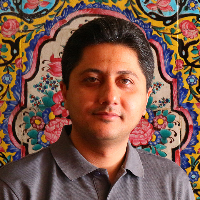Iconological Study of “Rustam in Struggle with Div-e Sepid” in Tilework of Karim Khan-e Zand Citadel Portal in Shiraz Based on Erwin Panofsky Method
The “Rustam and Div-e Sepid (White Demon)” tilework painting on the Karim Khan citadel (Arg) is one of the Qajarian’s interventions into this Zandian’s building. In addition to its artistic features, this work has a special social and governmental significance. However, it has received less attention from researchers. A new interpretation of it could provide a deeper understanding of the developments of the Zandian’s complex at Qajar era. The research is based on the hypotheses that this tilework in spite of its artistic role -in keeping with the Iranian tradition of illustrating the struggle of Rustam and Div-e Sepid in the art- also has non-artistic (political and governmental) functions.
The aim of the research is to recognize the content and conceptual aspects of this neglected tilework in its historical and social context and to identify its political and governmental functions in the Karim Khan citadel (Arg).
This study attempts to obtain a new understanding of the aforementioned tilework by “describing”, “analyzing” and “interpreting” the existing documents using the three stages of the iconography method of Erwin Panofsky in history of art studies. Primary data included archived images of the tilework and historical documents.
The findings show that: A) The primary or natural subject of this tilework was similar to other examples, however, the scene’s components such as “animals” and “elements of Western architecture” on the margins are different from previous samples; B) The secondary or conventional subject of this tilework illustrates Rustam’s struggle with Div-e Sepid (the thirteenth scene of the story narration) in the last stage of the Shahnameh Seven Adventures story called Haft Khan, which also undergoes some changes over time; C) The intrinsic meaning of this tilework with respect to the three subjects named “Artistic Backgrounds”, “Shiraz Government and Administrative Conditions” and “Symbolic Social and Political Implications” indicates that the use of these figures at the Karim Khan Citadel portal-at two levels of “Populace” and “Elite”- can serve as a visual medium for the transfer of the glory and political power of Fars governor Hussein-Ali Mirza Framanfarma as well as a symbol of his centrality, individuality, and independence against central government in Tehran. This artwork is to be interpreted as a part of other similar actions by the governor to announce the succession after Fath-Ali Shah Qajar.
- حق عضویت دریافتی صرف حمایت از نشریات عضو و نگهداری، تکمیل و توسعه مگیران میشود.
- پرداخت حق اشتراک و دانلود مقالات اجازه بازنشر آن در سایر رسانههای چاپی و دیجیتال را به کاربر نمیدهد.



